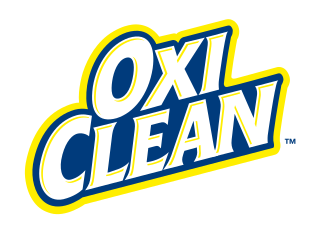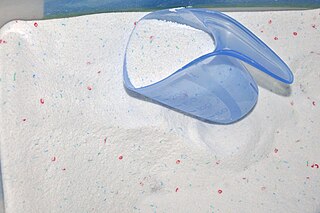
A dye is a colored substance that chemically bonds to the substrate to which it is being applied. This distinguishes dyes from pigments which do not chemically bind to the material they color. Dye is generally applied in an aqueous solution and may require a mordant to improve the fastness of the dye on the fiber.

Printmaking is the process of creating artworks by printing, normally on paper, but also on fabric, wood, metal, and other surfaces. "Traditional printmaking" normally covers only the process of creating prints using a hand processed technique, rather than a photographic reproduction of a visual artwork which would be printed using an electronic machine ; however, there is some cross-over between traditional and digital printmaking, including risograph.

Dry cleaning is any cleaning process for clothing and textiles using a solvent other than water.

Staining is a technique used to enhance contrast in samples, generally at the microscopic level. Stains and dyes are frequently used in histology, in cytology, and in the medical fields of histopathology, hematology, and cytopathology that focus on the study and diagnoses of diseases at the microscopic level. Stains may be used to define biological tissues, cell populations, or organelles within individual cells.

Paint stripper or paint remover is a chemical product designed to remove paint, finishes, and coatings, while also cleaning the underlying surface.

Dyeing is the application of dyes or pigments on textile materials such as fibers, yarns, and fabrics with the goal of achieving color with desired color fastness. Dyeing is normally done in a special solution containing dyes and particular chemical material. Dye molecules are fixed to the fiber by absorption, diffusion, or bonding with temperature and time being key controlling factors. The bond between dye molecule and fiber may be strong or weak, depending on the dye used. Dyeing and printing are different applications; in printing, color is applied to a localized area with desired patterns. In dyeing, it is applied to the entire textile.

OxiClean is an American brand of household cleaners, including OxiClean Versatile Stain Remover, which is a laundry additive, spot stain remover, and household cleaner marketed by Church & Dwight. It was formerly owned by Orange Glo International from its introduction in 1997 until it was acquired in 2006.

A primer or undercoat is a preparatory coating put on materials before painting. Priming ensures better adhesion of paint to the surface, increases paint durability, and provides additional protection for the material being painted.

Laundry detergent is a type of detergent used for cleaning dirty laundry (clothes). Laundry detergent is manufactured in powder and liquid form.

Wood finishing refers to the process of refining or protecting a wooden surface, especially in the production of furniture where typically it represents between 5 and 30% of manufacturing costs.

Bleach is the generic name for any chemical product that is used industrially or domestically to remove colour (whitening) from fabric or fiber or to clean or to remove stains in a process called bleaching. It often refers specifically to a dilute solution of sodium hypochlorite, also called "liquid bleach".
Stain removal is the process of removing a mark or spot left by one substance on a specific surface like a fabric. A solvent or detergent is generally used to conduct stain removal and many of these are available over the counter.

In textile manufacturing, finishing refers to the processes that convert the woven or knitted cloth into a usable material and more specifically to any process performed after dyeing the yarn or fabric to improve the look, performance, or "hand" (feel) of the finish textile or clothing. The precise meaning depends on context.
Blood residue are the wet and dry remnants of blood, as well the discoloration of surfaces on which blood has been shed. In forensic science, blood residue can help investigators identify weapons, reconstruct a criminal action, and link suspects to the crime. Analysis of blood residue is also an important technique in archeology.
Colour fastness is a term—used in the dyeing of textile materials—that characterizes a material's colour's resistance to fading or running. Colour fastness is the property of dyes and it is directly proportional to the binding force between photochromic dye and the fibre. The colour fastness may also be affected by processing techniques and choice of chemicals and auxiliaries.

The conservation and restoration of shipwreck artifacts is the process of caring for cultural heritage that has been part of a shipwreck. Oftentimes these cultural artifacts have been underwater for a great length of time. Without conservation, most artifacts would perish and important historical data would be lost. In archaeological terms, it is usually the responsibility of an archaeologist and conservator to ensure that material recovered from a shipwreck is properly cared for. The conservation phase is often time-consuming and expensive, which is one of the most important considerations when planning and implementing any action involving the recovery of artifacts from a shipwreck.

Tooth discoloration is abnormal tooth color, hue or translucency. External discoloration is accumulation of stains on the tooth surface. Internal discoloration is due to absorption of pigment particles into tooth structure. Sometimes there are several different co-existent factors responsible for discoloration.

The conservation and restoration of paintings is carried out by professional painting conservators. Paintings cover a wide range of various mediums, materials, and their supports. Painting types include fine art to decorative and functional objects spanning from acrylics, frescoes, and oil paint on various surfaces, egg tempera on panels and canvas, lacquer painting, water color and more. Knowing the materials of any given painting and its support allows for the proper restoration and conservation practices. All components of a painting will react to its environment differently, and impact the artwork as a whole. These material components along with collections care will determine the longevity of a painting. The first steps to conservation and restoration is preventive conservation followed by active restoration with the artist's intent in mind.
Enamel microabrasion is a procedure in cosmetic dentistry used to improve the appearance of the teeth. Like tooth whitening it is used to remove discolorations of the tooth surface but microabrasion is both a mechanical and chemical procedure.

Fabric treatments are processes that make fabric softer, or water resistant, or enhance dye penetration after they are woven. Fabric treatments get applied when the textile itself cannot add other properties. Treatments include, scrim, foam lamination, fabric protector or stain repellent, anti microbial and flame retardant.

















